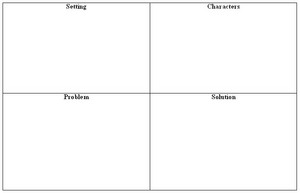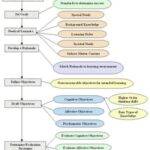Objective: Students will be able to:
1. Identify the elements of a story: the problem, solution, setting and characters, by writing them in a chart.
2. Orally give clues about his/her story.
3. Listen for clues that describe a story.
GLCEs:
R.NT.03.02 Identify and describe the basic elements and purpose of a variety of narrative genre including folktales, fables, and realistic fiction.
S.CN.03.03 Speak effectively emphasizing key words.
Anticipatory Set
The teacher will read the book “When Lightening Comes in a Jar” by Patricia Polacco. There will be a short discussion about what the students thought about it.
Instruction & Modeling
1. The teacher will display the book When Lightening Comes in a Jar.
2. The teacher will introduce the vocabulary for the lesson: problem, solution, setting, and characters, and will write these words on the board.
3. The teacher will introduce the chart and model how to fill in it in (on the overhead) using the Patricia Polacco book.
4. “What is the problem in this story? It seems Trisha really wants to know how to catch lightening in a jar, but Gramma tells her she has to wait.” “The solution is how the problem is solved. How is Trisha’s curiosity solved? Trisha has to wait until it turns dark, and then she finds out that her grandmother wasn’t talking about real lightening, but lightening bugs.” “The setting is where and when the story is taking place. This story is taking place at Trisha’s house, in the summer. Who are the characters in this story? The main character is Trisha. Then there are the aunts and uncles, the cousins, her favorite cousins Sandy and Lydia, and Gramma.”
Large Group Practice
4. The teacher will read a different Patricia Polacco book to the students.
5. The teacher will ask the students what the problem, solution, setting, and characters are.
6. The teacher will ask for volunteers to write down the responses on the overhead chart.
Small Group Practice
7. Students will work in pairs to complete a chart on a Patricia Polacco book that they choose. (All the books available to students should have already been read as a class.)
8. When their chart is complete, they will join another pair and give them clues to their story by reading off hints from their chart.
9. Each pair will try to guess the other pair’s story.
Individually
10. Each students will chose a Patricia Polacco book and fill in a chart. They will continue to identify the problem, conflict, characters and setting.
Closing
11. Students will come back together as a class and each student will give hints about their story as others try to guess the name of it.
12. The teacher will lead a class discussion about what made the hints too easy (such as naming the characters), and what hints were more challenging.
Evaluation
Formative Assessment: Students will be assessed by their answers during the large group practice and observations made by the teacher during small group practice.
Summative Assessment: Students will be assessed by whether they correctly completed a chart individually for a Patricia Polacco book.





